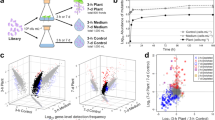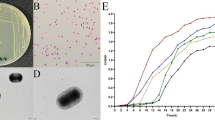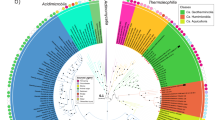Abstract
Members of the acI lineage of Actinobacteria are the most abundant microorganisms in most freshwater lakes; however, our understanding of the keys to their success and their role in carbon and nutrient cycling in freshwater systems has been hampered by the lack of pure cultures and genomes. We obtained draft genome assemblies from 11 single cells representing three acI tribes (acI-A1, acI-A7, acI-B1) from four temperate lakes in the United States and Europe. Comparative analysis of acI SAGs and other available freshwater bacterial genomes showed that acI has more gene content directed toward carbohydrate acquisition as compared to Polynucleobacter and LD12 Alphaproteobacteria, which seem to specialize more on carboxylic acids. The acI genomes contain actinorhodopsin as well as some genes involved in anaplerotic carbon fixation indicating the capacity to supplement their known heterotrophic lifestyle. Genome-level differences between the acI-A and acI-B clades suggest specialization at the clade level for carbon substrate acquisition. Overall, the acI genomes appear to be highly streamlined versions of Actinobacteria that include some genes allowing it to take advantage of sunlight and N-rich organic compounds such as polyamines, di- and oligopeptides, branched-chain amino acids and cyanophycin. This work significantly expands the known metabolic potential of the cosmopolitan freshwater acI lineage and its ecological and genetic traits.
Similar content being viewed by others
Log in or create a free account to read this content
Gain free access to this article, as well as selected content from this journal and more on nature.com
or
References
Allgaier M, Grossart HP . (2006). Diversity and seasonal dynamics of Actinobacteria populations in four lakes in northeastern Germany. Appl Environ Microbiol 72: 3489–3497.
Balashov SP, Imasheva ES, Choi AR, Jung K-H, Liaaen-Jensen S, Lanyi JK . (2010). Reconstitution of gloeobacter rhodopsin with echinenone: role of the 4-keto group. Biochemistry 49: 9792–9799.
Beier S, Bertilsson S . (2011). Uncoupling of chitinase activity and uptake of hydrolysis products in freshwater bacterioplankton. Limnol Oceanogr 56: 1179–1188.
Buck U, Grossart HP, Amann R, Pernthaler J . (2009). Substrate incorporation patterns of bacterioplankton populations in stratified and mixed waters of a humic lake. Environ Microbiol 11: 1854–1865.
Carini P, Steindler L, Beszteri S, Giovannoni SJ . (2013). Nutrient requirements for growth of the extreme oligotroph “Candidatus Pelagibacter ubique” HTCC1062 on a defined medium. ISME J 7: 592–602.
Chou HT, Kwon D-H, Hegazy M, Lu C-D . (2008). Transcriptome analysis of agmatine and putrescine catabolism in Pseudomonas aeruginosa PAO1. J Bacteriol 190: 1966–1975.
Dasu VV, Nakada Y, Ohnishi-Kameyama M, Kimura K, Itoh Y . (2006). Characterization and a role of Pseudomonas aeruginosa spermidine dehydrogenase in polyamine catabolism. Microbiology 152: 2265–2272.
DeLong EF, Beja O . (2010). The light-driven proton pump proteorhodopsin enhances bacterial survival during tough times. PLoS Biol 8: e1000359.
Eckert EM, Baumgartner M, Huber IM, Pernthaler J . (2013). Grazing resistant freshwater bacteria profit from chitin and cell-wall derived organic carbon. Environ Microbiol 15: 2019–2030.
Eckert EM, Salcher MM, Posch T, Eugster B, Pernthaler J . (2012). Rapid successions affect microbial N-acetyl-glucosamine uptake patterns during a lacustrine spring phytoplankton bloom. Environ Microbiol 14: 794–806.
Eddy SR . (2011). Accelerated profile HMM searches. PLoS Comput Biol 7: e1002195.
Eiler A, Zaremba-Niedzwiedzka K, Andersson SGE, Martinez-Garcia M, McMahon KD, Stepanauskas R et al. (2013). Productivity and salinity structuring of the microplankton revealed by comparative freshwater metagenomics. Environ Microbiol in press.
Fueser G, Steinbuechel A . (2007). Analysis of genome sequences for genes of cyanophycin metabolism: identifying putative cyanophycin metabolizing prokaryotes. Macromol Biosci 7: 278–296.
Garcia SL, McMahon KD, Grossart H-P, Warnecke F . (2014). Successful enrichment of the ubiquitous freshwater acI Actinobacteria. Environ Microbiol Rep 6: 21–27.
Garcia SL, McMahon KD, Martinez-Garcia M, Srivastava A, Sczyrba A, Stepanauskas R et al. (2013). The metabolic potential of a single cell belonging to one of the most abundant lineages in freshwater bacterioplankton. ISME J 7: 137–147.
Ghai R, McMahon KD, Henrique-Silva F . (2011). Metagenomics of the water column in the pristine upper course of the Amazon River. PLoS One 6: e23785.
Ghai R, McMahon KD, Rodriguez-Valera F . (2012). Breaking a paradigm: cosmopolitan and abundant freshwater Actinobacteria are low GC. Environ Microbiol Rep 4: 29–35.
Glockner FO, Zaichikov E, Belkova N, Denissova L, Pernthaler J, Pernthaler A et al. (2000). Comparative 16S rRNA analysis of lake bacterioplankton reveals globally distributed phylogenetic clusters including an abundant group of actinobacteria. Appl Environ Microbiol 66: 5053–5065.
Gnerre S, Maccallum I, Przybylski D, Ribeiro FJ, Burton JN, Walker BJ et al. (2011). High-quality draft assemblies of mammalian genomes from massively parallel sequence data. Proc Natl Acad Sci USA 108: 1513–1518.
Gómez-Consarnau L, Akram N, Lindell K, Pedersen A, Neutze R, Milton DL et al. (2010). Proteorhodopsin phototrophy promotes survival of marine bacteria during starvation. PLoS Biol 8: e1000358.
Gomez-Consarnau L, Gonzalez JM, Coll-Llado M, Gourdon P, Pascher T, Neutze R et al. (2007). Light stimulates growth of proteorhodopsin-containing marine Flavobacteria. Nature 445: 210–213.
González JM, Fernández-Gómez B, Fernàndez-Guerra A, Gómez-Consarnau L, Sánchez O, Coll-Lladó M et al. (2008). Genome analysis of the proteorhodopsin-containing marine bacterium Polaribacter sp. MED152 (Flavobacteria). Proc Natl Acad Sci USA 105: 8724–8729.
Grote J, Thrash JC, Huggett MJ, Landry ZC, Carini P, Giovannoni SJ et al. (2012). Streamlining and core genome conservation among highly divergent members of the SAR11 clade. MBio 3: e00252–12.
Hacker J, Kaper JB . (2000). Pathogenicity islands and the evolution of microbes. Annu Rev Microbiol 54: 641–679.
Humbert JF, Dorigo U, Cecchi P, Le Berre B, Debroas D, Bouvy M . (2009). Comparison of the structure and composition of bacterial communities from temperate and tropical freshwater ecosystems. Environ Microbiol 11: 2339–2350.
Hyatt D, Chen G-L, LoCascio PF, Land ML, Larimer FW, Hauser LJ . (2010). Prodigal: prokaryotic gene recognition and translation initiation site identification. BMC Bioinformatics 11: 119.
Imasheva ES, Balashov SP, Choi AR, Jung K . (2009). Reconstitution of Gloeobacter violaceus rhodopsin with a light-harvesting carotenoid antenna. Biochemistry 48: 10948–10955.
Jones SE, Newton RJ, McMahon KD . (2009). Evidence for structuring of bacterial community composition by organic carbon source in temperate lakes. Environ Microbiol 11: 2463–2472.
Konstantinidis KT, Tiedje JM . (2007). Prokaryotic taxonomy and phylogeny in the genomic era: advancements and challenges ahead. Curr Opin Microbiol 10: 504–509.
Krehenbrink M, Oppermann-Sanio FB, Steinbuchel A . (2002). Evaluation of non-cyanobacterial genome sequences for occurrence of genes encoding proteins homologous to cyanophycin synthetase and cloning of an active cyanophycin synthetase from Acinetobacter sp strain DSM 587. Arch Microbiol 177: 371–380.
Ludwig W, Strunk O, Westram R, Richter L, Meier H, Yadhukumar et al. (2004). ARB: a software environment for sequence data. Nucleic Acids Res 32: 1363–1371.
Luecke H, Schobert B, Stagno J, Imasheva ES, Wang JM, Balashov SP et al. (2008). Crystallographic structure of xanthorhodopsin, the light-driven proton pump with a dual chromophore. Proc Natl Acad Sci USA 105: 16561–16565.
Magnuson JJ, Kratz TK, Benson BJ . (2006). Long term dynamics of lakes in the landscape, Oxford University Press: New York, USA.
Makarova KS, Aravind L, Galperin MY, Grishin NV, Tatusov RL, Wolf YI et al. (1999). Comparative genomics of the archaea (Euryarchaeota): evolution of conserved protein families, the stable core, and the variable shell. Genome Res 9: 608–628.
Markowitz VM, Chen I-M a, Palaniappan K, Chu K, Szeto E, Grechkin Y et al. (2012). IMG: the integrated microbial genomes database and comparative analysis system. Nucleic Acids Res 40: D115–D122.
Martinez A, Bradley AS, Waldbauer JR, Summons RE, Delong EF . (2007). Proteorhodopsin photosystem gene expression enables photophosphorylation in a heterologous host. Proc Natl Acad Sci USA 104: 5590–5595.
Martinez-Garcia M, Swan BK, Poulton NJ, Gomez ML, Masland D, Sieracki ME et al. (2012). High-throughput single-cell sequencing identifies photoheterotrophs and chemoautotrophs in freshwater bacterioplankton. ISME J 6: 113–123.
Newton RJ, Jones SE, Eiler A, McMahon KD, Bertilsson S . (2011). A guide to the natural history of freshwater lake bacteria. Microbiol Mol Biol Rev 75: 14–49.
Newton RJ, Jones SE, Helmus MR, McMahon KD . (2007). Phylogenetic ecology of the freshwater Actinobacteria acI lineage. Appl Environ Microbiol 73: 7169–7176.
Newton RJ, Kent AD, Triplett EW, McMahon KD . (2006). Microbial community dynamics in a humic lake: differential persistence of common freshwater phylotypes. Environ Microbiol 8: 956–970.
Obst M, Oppermann-Sanio FB, Luftmann H, Steinbuchel A . (2002). Isolation of cyanophycin-degrading bacteria, cloning and characterization of an extracellular cyanophycinase gene (cphE) from Pseudomonas anguilliseptica strain BI - The cphE gene from P-anguilliseptica BI encodes a cyanophycin-hydrolyzing enzyme. J Biol Chem 277: 25096–25105.
Obst M, Sallam A, Luftmann H, Steinbuchel A . (2004). Isolation and characterization of gram-positive cyanophycin-degrading bacteria - Kinetic studies on cyanophycin depolymerase activity in aerobic bacteria. Biomacromolecules 5: 153–161.
Perez MT, Hortnagl P, Sommaruga R . (2010). Contrasting ability to take up leucine and thymidine among freshwater bacterial groups: implications for bacterial production measurements. Environ Microbiol 12: 74–82.
Poretsky RS, Sun S, Mou XZ, Moran MA . (2010). Transporter genes expressed by coastal bacterioplankton in response to dissolved organic carbon. Environ Microbiol 12: 616.
Pruesse E, Quast C, Knittel K, Fuchs BM, Ludwig W, Peplies J et al. (2007). SILVA: a comprehensive online resource for quality checked and aligned ribosomal RNA sequence data compatible with ARB. Nucleic Acids Res 35: 7188–7196.
Punta M, Coggill PC, Eberhardt RY, Mistry J, Tate J, Boursnell C et al. (2012). The Pfam protein families database. Nucleic Acids Res 40: D290–D301.
Richter R, Hejazi M, Kraft R, Ziegler K, Lockau W . (1999). Cyanophycinase, a peptidase degrading the cyanobacterial reserve material multi-L-arginyl-poly-L-aspartic acid (cyanophycin) - Molecular cloning of the gene of Synechocystis sp PCC 6803, expression in Escherichia coli, and biochemical characterization of. Eur J Biochem 263: 163–169.
Riedel T, Gomez-Consarnau L, Tomasch J, Martin M, Jarek M, Gonzlez JM et al. (2013). Genomics and physiology of a marine Flavobacterium encoding a proteorhodopsin and a xanthorhodopsin- like protein. PLoS One 8: e57487.
Rocha EP . (2004). Codon usage bias from tRNA’s point of view: redundancy, specialization, and efficient decoding for translation optimization. Genome Res 14: 2279–2286.
Rösel S, Grossart H . (2012). Contrasting dynamics in activity and community composition of free-living and particle-associated bacteria in spring. Aquat Microb Ecol 66: 169–181.
Saier MH, Yen MR, Noto K, Tamang DG, Elkan C . (2009). The transporter classification database: recent advances. Nucleic Acids Res 37: D274–D278.
Salcher MM, Pernthaler J, Posch T . (2010). Spatiotemporal distribution and activity patterns of bacteria from three phylogenetic groups in an oligomesotrophic lake. Limnol Oceanogr 55: 846–856.
Salcher MM, Posch T, Pernthaler J . (2013). In situ substrate preferences of abundant bacterioplankton populations in a prealpine freshwater lake. ISME J 7: 896–907.
Salka I, Wurzbacher C, Garcia SL, Labrenz M, Jurgens K, Grossart HP . (2014). Distribution of acI-Actinorhodopsin genes in Baltic Sea salinity gradients indicates adaptation of facultative freshwater photoheterotrophs to brackish waters. Environ Microbiol 16: 586–597.
Sallam A, Kalkandzhiev D, Steinbüchel A . (2011). Production optimization of cyanophycinase ChpE al from Pseudomonas alcaligenes DIP1. AMB Express 1: 38.
Sharma AK, Sommerfeld K, Bullerjahn GS, Matteson AR, Wilhelm SW, Jezbera J et al. (2009). Actinorhodopsin genes discovered in diverse freshwater habitats and among cultivated freshwater Actinobacteria. ISME J 3: 726–737.
Sharma AK, Zhaxybayeva O, Papke RT, Doolittle WF . (2008). Actinorhodopsins: proteorhodopsin-like gene sequences found predominantly in non-marine environments. Environ Microbiol 10: 1039–1056.
Sharp PM, Li WH . (1987). The codon Adaptation Index—a measure of directional synonymous codon usage bias, and its potential applications. Nucleic Acids Res 15: 1281–1295.
Stamatakis A, Hoover P, Rougemont J . (2008). A Rapid Bootstrap Algorithm for the RAxML Web Servers. Syst Biol 57: 758–771.
Steindler L, Schwalbach MS, Smith DP, Chan F, Giovannoni SJ . (2011). Energy starved Candidatus Pelagibacter ubique substitutes light-mediated ATP production for endogenous carbon respiration. PLoS One 6: e19725.
Tada Y, Grossart H-P . (2014). Community shifts of actively growing lake bacteria after N-acetyl-glucosamine addition: improving the BrdU-FACS method. ISME J 8: 441–454.
Vollmers J, Voget S, Dietrich S, Gollnow K, Smits M, Meyer K et al. (2013). Poles apart: Arctic and Antarctic Octadecabacter strains share high genome plasticity and a new type of xanthorhodopsin. PLoS One 8: e63422.
Warnecke F, Sommaruga R, Sekar R, Hofer JS, Pernthaler J . (2005). Abundances, identity, and growth state of Acintobacteria in mountain lakes of different UV transparency. Appl Environ Microbiol 71: 5607–5609.
Woyke T, Xie G, Copeland A, Gonzalez JM, Han C, Kiss H et al. (2009). Assembling the marine metagenome, one cell at a time. PLoS One 4: e5299.
Wu X, Xi W, Ye W, Yang H . (2007). Bacterial community composition of a shallow hypertrophic freshwater lake in China, revealed by 16S rRNA gene sequences. FEMS Microbiol Ecol 61: 85–96.
Wurzbacher C, Salka I, Grossart H-P . (2012). Environmental actinorhodopsin expression revealed by a new in situ filtration and fixation sampler. Environ Microbiol Rep 4: 491–497.
Zakharova YR, Kurilkina MI, Likhoshvay AV, Shishlyannikov SM, Kalyuzhnaya OV, Petrova DP et al. (2013). Effect of bacteria from the bottom water layer of lake Baikal on degradation of diatoms. Paleontol J 47: 1030–1034.
Zerbino DR, Birney E . (2008). Velvet: algorithms for de novo short read assembly using de Bruijn graphs. Genome Res 18: 821–829.
Acknowledgements
We thank Dr Todd Miller and Sara Yeo for collecting the original water samples used to retrieve single cells from Lake Mendota and Sparkling Lake. We thank the Join Genome Institute for supporting this work through the Community Sequencing Program, performing the bioinformatics and providing technical support. We would also like to acknowledge the Biotechnology Training Program of the National Institutes of Health at the University of Wisconsin-Madison for providing financial support for TWG’s research and training (grant #5T32GM08349). The work conducted by the U.S. Department of Energy Joint Genome Institute is supported by the Office of Science of the U.S. Department of Energy under Contract No. DE-AC02-05CH11231. KDM acknowledges funding from the United States National Science Foundation Microbial Observatories program (MCB-0702395), the Long Term Ecological Research program (NTL-LTER DEB-0822700), an INSPIRE award (DEB-1344254) and the Swedish Wenner-Gren Foundation. This material is based upon work supported by the National Institute of Food and Agriculture, United States Department of Agriculture, under ID number WIS01516 (to KDM). RS acknowledges funding from the United States National Science Foundation (DEB-0841933, OCE-0821374, EF-0633142, and MCB-0738232). SB acknowledges funding from the Swedish Research Council and H-PG acknowledges funding from the German Science Foundation (DFG GR1540/17-1). SLG thanks JSMC for funding.
Author information
Authors and Affiliations
Corresponding author
Ethics declarations
Competing interests
The authors declare no conflict of interest.
Additional information
Article dedicated to co-author Falk Warnecke
This article is dedicated to the memory of one of our co-authors, Falk Warnecke, who passed away just before its publication.
Supplementary Information accompanies this paper on The ISME Journal website
Supplementary information
Rights and permissions
About this article
Cite this article
Ghylin, T., Garcia, S., Moya, F. et al. Comparative single-cell genomics reveals potential ecological niches for the freshwater acI Actinobacteria lineage. ISME J 8, 2503–2516 (2014). https://doi.org/10.1038/ismej.2014.135
Received:
Revised:
Accepted:
Published:
Issue date:
DOI: https://doi.org/10.1038/ismej.2014.135
This article is cited by
-
Effects of carbon source addition in rearing water on sediment characteristics, growth and health of cultured marron (Cherax cainii)
Scientific Reports (2024)
-
Microbial genome (Illumina MiSeq) sequencing of drinking water treatment residuals to evaluate compatibility with environmental applications
Environmental Monitoring and Assessment (2023)
-
Temporal and Spatial Variation Characteristics and Influencing Factors of Bacterial Community in Urban Landscape Lakes
Microbial Ecology (2023)
-
Temporal and spatial differences of the under-ice microbiome are linked to light transparency and chlorophyll-a
Hydrobiologia (2022)
-
Microbial river-to-sea continuum: gradients in benthic and planktonic diversity, osmoregulation and nutrient cycling
Microbiome (2021)



